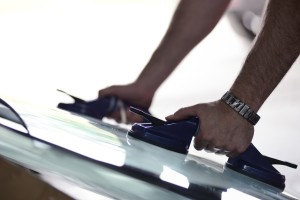Vern's Collision Blog
Back to all postsDealer Glass vs. OEM Glass vs. Aftermarket Glass
 Your vehicle’s windshield can make up anywhere from 45% to 60% of your vehicle’s cabin strength in an accident. In fact, this was a hot topic at 2014’s Independence Day Conference and Spring Auto Glass Show, in Las Vegas. Ralph Nader gave a compelling presentation regarding the difference that high quality auto glass can make. The right auto glass provides protection for up to 3 consecutive rollovers in a vehicle, as the windshield glass should be able to sustain 1.5 times the vehicle’s weight. Cheap or poorly made auto glass will become crushed in 1 rollover, and usually the roof crushes in with the vehicle. You may be thinking, “That would never happen to me!” And you could be right. Vehicle rollovers account for only 3% of accidents… Yet rollover accidents still account for more than 30% of all vehicle related fatalities! Simply put, your auto glass is not something you should take (or replace) lightly. At Vern’s Collision and Glass, we promote saving money, but not at the risk of your own safety. This is why we advocate OEM glass; and all OEM repair parts for your vehicle.
Your vehicle’s windshield can make up anywhere from 45% to 60% of your vehicle’s cabin strength in an accident. In fact, this was a hot topic at 2014’s Independence Day Conference and Spring Auto Glass Show, in Las Vegas. Ralph Nader gave a compelling presentation regarding the difference that high quality auto glass can make. The right auto glass provides protection for up to 3 consecutive rollovers in a vehicle, as the windshield glass should be able to sustain 1.5 times the vehicle’s weight. Cheap or poorly made auto glass will become crushed in 1 rollover, and usually the roof crushes in with the vehicle. You may be thinking, “That would never happen to me!” And you could be right. Vehicle rollovers account for only 3% of accidents… Yet rollover accidents still account for more than 30% of all vehicle related fatalities! Simply put, your auto glass is not something you should take (or replace) lightly. At Vern’s Collision and Glass, we promote saving money, but not at the risk of your own safety. This is why we advocate OEM glass; and all OEM repair parts for your vehicle.
That’s one of the reasons why we want to take a few moment and tell you about the 3 types of glass that an installer can select from, when replacing your windshield:
The first is known as “Dealer Glass.” Dealer glass is auto glass you purchase from your vehicle dealer. It’s authorized by the vehicle manufacturer to service your car. This is actually the same glass as what you’d get from an OEM distributor. The difference is it has the vehicle’s make stamped on it. It’s also much more expensive because of the name brand. To note: Some dealers may only provide “aftermarket glass” so do not instantly assume the dealer you choose uses “Dealer Glass” or “OEM Glass.”
Next we have “OEM Glass.” OEM means Original Equipment Manufacturer. OEM glass is made to the same specifications as dealer glass. The difference is that it’s not necessarily made by the same distributor. It will be the same shape, size, thickness, durability and color as what your major vehicle brand makes on the original vehicle. The reason OEM glass exists, is because vehicle companies change auto glass contracts every year. The company that made the glass for your older vehicle is not likely to be the same company that makes the glass for your vehicle today. However, this is usually both the safest and most affordable auto glass option.
And lastly, there’s “Aftermarket or OEE Glass.” Aftermarket glass is created by independent companies that do not have a direct contract with car manufacturers, and therefore cannot legally create glass with the same specifications as OEM glass. (A good example of OEE glass, is the glass manufactured and used by Safelite.) Usually the glass is thicker, and in many cases dealerships won’t let you return a leased vehicle with OEE glass, simply because the difference in quality is too great. This may be significantly cheaper glass, but it’s usually not your best choice.
The quality of your auto glass, determines the safety of your vehicle. Vern’s Collision and Glass understands you work hard for your money and that your car is an important staple in your life.





